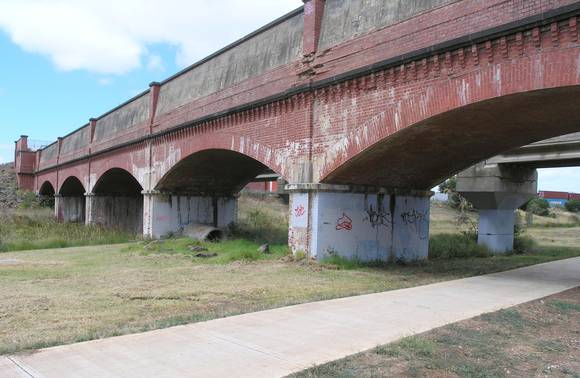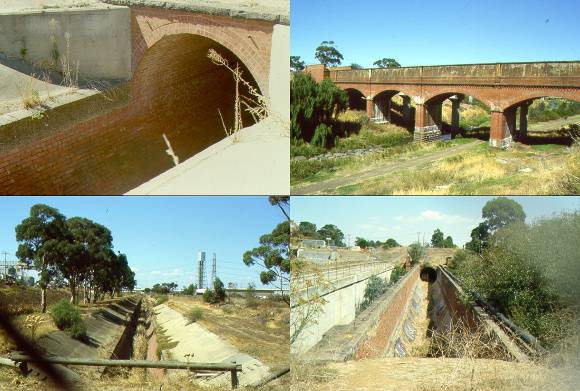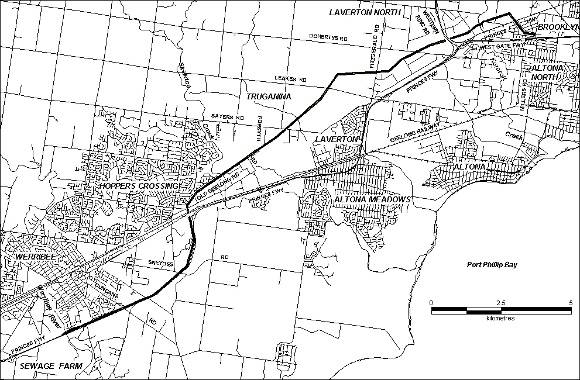| Back to search results » | Back to search page » |
|
MAIN OUTFALL SEWER
Other NamesMELBOURNE OUTFALL SEWER , MOS , Federation Trail LocationBROOKLYN AND LAVERTON NORTH AND TRUGANINA AND HOPPERS CROSSING AND WERRIBEE AND WILLIAMS LANDING, BRIMBANK CITY, HOBSONS BAY CITY, WYNDHAM CITY
File Number09/002303 [1-2] [closed]LevelRegistered |
|
Statement of Significance
What is significant?
The Main Outfall Sewer was constructed in
1892-4 and was a vital link in the sewerage system of Melbourne which,
when it was constructed in the 1890s, was the largest civil
engineering project ever undertaken in Victoria. The Main Outfall
Sewer consists of a semicircular brick or concrete lined channel (in
places arched over to form a circular tunnel with an earth covering)
and three brick arched aqueducts. The sewer was constructed by seven
contractors employing 1300 workers and cost £240,748. During the 1880s
the phenomenal growth of Melbourne led to a crisis in sanitation. The
situation was exacerbated by the existence within the metropolitan
area of many municipalities which would have to agree on any sewerage
system. A Royal Commission recommended the formation of a Metropolitan
Board of Works, comprised of commissioners from each of the local
government authorities, with responsibility for both water supply and
sewerage. Eminent British engineer James Mansergh was appointed to
advise on a suitable system. At a time when most cities dumped their
untreated wastes directly into rivers and the sea, Mansergh advised
treatment of Melbourne?s sewage by broad irrigation with a capacity
large enough able to deal with the expansion in population expected
over 50 years. The system he conceived and which was implemented in
only slightly modified form began with a water closet at every
property which delivered the sewage by gravity through a network of
underground sewers of increasing diameter to a steam pumping station
at Spotswood (VHR 1555) where it was forced up wrought iron rising
mains to Brooklyn to begin its 25 kilometre journey along the Main
Outfall Sewer to the sewage farm at Werribee. As could be expected,
the Main Outfall Sewer has had much repair and replacement of fabric
over the last century and its function has now been entirely replaced
by the Western Trunk Sewer. Nonetheless, there is still extensive
original fabric remaining within its easement.
How is it significant?
The Main Outfall Sewer is of historical
and scientific (engineering) significance to the State of Victoria.
Why is it significant?
The Main Outfall Sewer is historically
important as an artefact of the process of development of Melbourne
into a modern metropolis. The decision in 1890 to build a sewerage
system with a capacity well in excess of the contemporary population
was far sighted. The project not only addressed an existing sanitary
crisis, but also enabled expansion of the city into new areas because
the ?downstream? sewerage infrastructure was of sufficient capacity.
Unlike the rest of the system which is underground and out of sight,
the Main Outfall Sewer is a visible manifestation of the entire
system. The Main Outfall Sewer is also a tangible link with the
formation of the Melbourne Metropolitan Board of Works whose role as
the unifying force for major infrastructure projects in Melbourne over
the last century is of enormous historical importance. The
construction of the system is all the more remarkable because,
although conceived during the years of the 1880s Boom, its completion
was achieved during the years of the catastrophic 1890s Depression.
The Main Outfall Sewer is of scientific (engineering) importance
as a major link in the most extensive engineering project undertaken
in Victoria to that date. The concrete and brick open and covered
sewer is a fine example of the technology of the period, exhibiting a
high level of integrity. The three major red brick aqueducts over
Kororoit Creek, Skeleton Creek and the Werribee River are excellent
examples of multi-spanned, arched masonry bridges.
Group
Utilities - Sewerage
Category
Sewage Aqueduct







